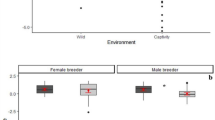Abstract
In this paper we describe tolerated mouth-to-mouth food transfers in captive adult common marmosets, where an animal approached a conspecific that has recently received a piece of food, opened the other’s mouth forcefully, and picked food pieces out of it. Tolerated mouth-to-mouth food transfers occurred between animals of both sexes. They were observed when the possessor was subordinate as well as when it was dominant, and in four dyads they were observed in both directions. We argue that this behaviour might have a social function and that the cooperative breeding system of marmosets might have facilitated its evolution.

Similar content being viewed by others
References
Baldwin J (1968) The social behavior of adult male squirrel monkeys (Saimiri sciureus) in a seminatural environment. Folia Primatol 9:281–314
Barrett L, Henzi P (2005) The social nature of primate cognition. Proc R Soc B 272:1865–1875
Brown K, Mack DS (1978) Food sharing among captive Leonthopithecus rosalia. Folia Primatol 29:268–290
Brown G, Almond R, van Bergen Y (2004) Begging, stealing, and offering: food transfer in nonhuman primates. Adv Study Behav 34:265–295
de Waal FBM (2000) Attitudinal reciprocity in food sharing among brown capuchin monkeys. Anim Behav 60:253–261
Feistner ATC, Price EC (1991) Food offering in new world primates: two species added. Folia Primatol 57:165–168
Ferrari SF (1987) Food transfer in a wild marmoset group. Folia Primatol 48:203–206
Ferrari SF, Digby LJ (1996) Wild Callithrix groups: stable extended families? Am J Primatol 38:19–27
Goodall J (1986) The chimpanzees of Gombe: patterns of behavior. Harvard University Press, Cambridge, MA
Hall K, Mayer B (1967) Social interactions in a group of captive patas monkeys (Erythrocebus patas). Folia Primatol 5:213–236
Nievergelt CM, Digby LJ, Ramakrishnan U, Woodruff DS (2000) Genetic analysis of group composition and breeding system in a wild common marmoset (Callithrix jacchus) population. Int J Primatol 21:1–21
Perry S, Baker M, Fedigan L, Gros-Louis J, Jack K, MacKinnon K, Manson J, Panger M, Pyle K, Rose L (2003) Social conventions in wild white-faced Capuchin monkeys. Curr Anthropol 44:241–268
Peters M (1970) Mouth to mouth contact in squirrel monkeys (Saimiri sciureus). Z Tierpsychol 27:1009–1010
Rapaport L (2001) Food transfer among adult lion tamarins: mutualism, reciprocity or one-sided relationships? Int J Primatol 22:611–629
Roush RS, Snowdon CT (2001) Food transfer and development of feeding behaviour and food-associated vocalizations in cotton-top tamarins. Ethology 107:415–429
Ruiz-Miranda CR, Kleimann DG, Dietz JM, Moraes E, Gravitol AD, Baker AJ, Beck BB (1999) Food transfers in wild and reintroduced golden lion tamarins, Leonthopithecus rosalia. Am J Primatol 48:305–320
Stevenson M, Poole T (1976) An ethogram of the common marmoset (Callithrix jacchus jacchus). General behavioural repertoire. Anim Behav 24:428–451
Struhsaker T (1967) Behavior of vervet monkeys (Cercopithecus aethiops). University of California Press, Berkeley, CA
Struhsaker T (1969) Correlates of ecology and social organizations among African cercopitecines. Folia Primatol 11:80–118
van Kreveld D (1970) A selective view of dominance–subordination relations in mammals. Genet Psychol Monogr 81:141–173
Voelkl B, Schrauf C, Huber L (2006) Social contact influences the response of infant marmosets towards novel food. Anim Behav 72:365–372
Zahavi A (1977) The testing of a bond. Anim Behav 25:246–247
Acknowledgments
This research was conducted at the Konrad Lorenz Institute for Evolution and Cognition Research in Altenberg, Austria. We are very grateful to Gustl Anzenberger for his valuable comments and Dan Fahey for improving the English of the manuscript. This study was conducted with marmosets that had all been born in captivity and was performed in accordance with the Austrian legal regulations for the use of animals in experiments, as well as the guidelines of the Association for the Study of Animal Behaviour (ASAB). We thank Toshisada Nishida and two anonymous referees for their appreciated comments and constructive criticism.
Author information
Authors and Affiliations
Corresponding author
About this article
Cite this article
Kasper, C., Voelkl, B. & Huber, L. Tolerated mouth-to-mouth food transfers in common marmosets. Primates 49, 153–156 (2008). https://doi.org/10.1007/s10329-007-0069-7
Received:
Accepted:
Published:
Issue Date:
DOI: https://doi.org/10.1007/s10329-007-0069-7




